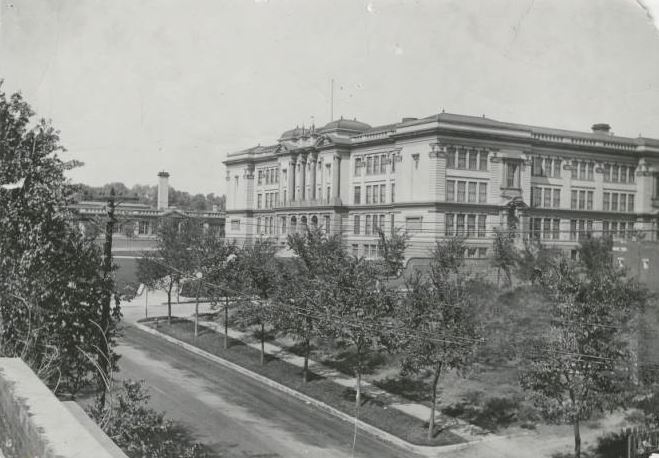
Insight: School Design
Insight: School Design by Billy Gregg My daughter just choiced into Denver North High School next year. If it works out she will have attended Edison Elementary, Skinner Middle School and North in order making her a local girl for sure.
Insight: School Design by Billy Gregg
My daughter just choiced into Denver North High School next year. If it works out she will have attended Edison Elementary, Skinner Middle School and North in order making her a local girl for sure. All of these schools have been in service since the early 1900’s and all of them are clear expressions of the architectural and civic sensibilities of the time. Each of the schools used brick or stone organized around an underlying neo-classical order that makes it easy to identify as a civic building. I remember liking Edison just looking at the architecture. It has that civic gravitas but, because it was intended for children, the architects took a playful approach to detail and decoration. The result evokes a castle or manor home and I liked thinking that the school, as architecture, would live in her memory as much as her teachers and her friends.
 North High School is more ambitious. The original building is very much an expression of the early 20th Century City Beautiful movement; in which politicians and design practitioners exploited civic design opportunities to construct a framework of roads and buildings that the nascent community could grow up around. The school is on high ground and features a spectacular view back to Denver’s downtown. It also functions as the northwestern terminus of Speer Boulevard. The boulevard is the centerpiece of the City’s historic Parks and Parkways system. Each of the first four high schools in Denver: North, East, South and West, are sited at a major park or on a Parkway. Again, I like thinking that the school, as architecture, may color her experience as much as her work or her teachers or her friends. I also like the fact that both the basis of design and the curriculum are rooted in the humanities and liberal arts, giving everyone in our neighborhood the opportunity to participate in an established, continuous tradition that defines the City and continuously replenishes it’s citizenry.
North High School is more ambitious. The original building is very much an expression of the early 20th Century City Beautiful movement; in which politicians and design practitioners exploited civic design opportunities to construct a framework of roads and buildings that the nascent community could grow up around. The school is on high ground and features a spectacular view back to Denver’s downtown. It also functions as the northwestern terminus of Speer Boulevard. The boulevard is the centerpiece of the City’s historic Parks and Parkways system. Each of the first four high schools in Denver: North, East, South and West, are sited at a major park or on a Parkway. Again, I like thinking that the school, as architecture, may color her experience as much as her work or her teachers or her friends. I also like the fact that both the basis of design and the curriculum are rooted in the humanities and liberal arts, giving everyone in our neighborhood the opportunity to participate in an established, continuous tradition that defines the City and continuously replenishes it’s citizenry.
“What are you choosing and what are you leaving behind?”In contrast, charters and other public schools are catering to increasingly narrower sectors in our community. Choice in this marketplace is often based on reducing the interdependence of the academic disciplines and putting an emphasis on one course of study or another. The reduction is marketed as “focus”. “Focus” comes with the assurance that specialization will allow your child to follow her heart (assuming it is known to her) while providing her with a competitive advantage going forward. These days, you choose or “choice” as they say whether you want to or not. In that process the family identified connection to community, dedication to a broad, liberal arts, curriculum and design that supported both as a mutually reinforcing set of criteria for school choice. In considering our options, the question became, “What are you choosing and what are you leaving behind?”
Out in the greenfields of the suburbs, the big parochial and public schools may have strong liberal arts curriculums but they also compete in the marketplace. “Focus” at these schools is on organizations outside of academics: Special interest clubs and athletics for example, and contemporary design reflects that. I had a chance to walk around the campus at Columbine High School the other day. It’s a unique site, in a corner of Clement Park fronting Pierce Street in Littleton. I’m not sure why but the school doesn’t engage the street or park at all. I know the building has depth but the dominant impression I came away with was a little like big box retail. The school has two sides: The front oriented to parking and the back dedicated to service access. Beyond the truck turn-around and loading docks the school’s athletic facilities are crowded together in a maze of fenced walks and paths that divide the school from the park.
City Beautiful, the movement that gave us North High, assumed that every public building presented an opportunity to contribute to and strengthen the physical framework of the community. North was part of a larger vision and continues to serve as a resource for those who wish to sustain that vision. Columbine caters less to the community and more to individual students but, with community, curriculum and design serving as a standard for criticism, I have to ask, “What if I’m not buying what they are selling?”
